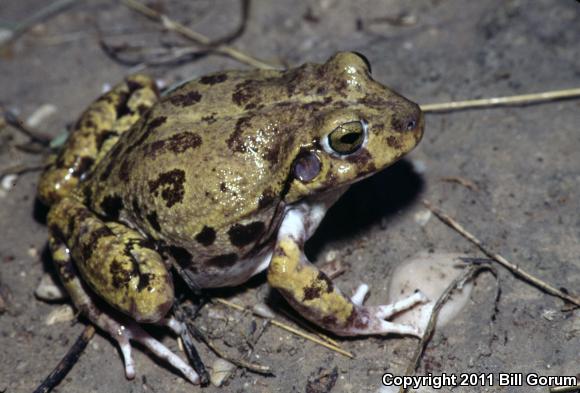| Range: |
 |
| Other Names: |
Balcone's Barking Frog, Common Robber Frog, Cliff Frog |
| Subspecies: |
Eastern Barking Frog Craugastor augusti latrans |
| Description: |
To about 3.75 inches in length, adults of this toad-like frog are olive-gray to rusty-gray with dark irregularly shaped spots or blotches. The barking frog is distinguished from other New Mexico anurans by a fold of skin across the back of the head (intertympanic fold) and tubercles on the feet. The toes are not webbed. Females are larger than males and have pink tympana and white throats year-round, while males have dark tympana, and adult males have a dark throat in the breeding season. Small juvenile frogs can look like the adults or may have large black patches on the head and lower body. |
| Similar Species: |
The lack of webbing between the toes, the abdominal disc and large adult size should separate this species from all other anurans in New Mexico The distinctive dorsal coloration of the juvenile is diagnostic. |
| Habitat: |
Barking frogs are found in outcrops or caves on rocky slopes in often scrubby oak or pine-oak woodlands at elevations of about 4,200-6,200 feet. Habitats are characterized by outcrops of limestone, rhyolite, granite, and perhaps other rock types with deep fissures, holes, and caverns where barking frogs can escape climatic extremes. |
| Behavior: |
This species may exhibit complex courtship behavior, including males leading females from aestivation sites to breeding locales. Females likely stay with the eggs until they hatch, and may help maintain egg moisture levels by excretion. |
| Hibernation: |
|
| Reproduction: |
This frog is very difficult to find; most are located by their distinctive and loud "Walk! Walk!" call, which is made from rock outcrops at the beginning of the monsoons. Frogs call dependably for only two or three nights following the first heavy monsoon storm of the season, but may be heard sporadically for another 2-4 weeks. Unlike other frogs and toads in New Mexico, this species lacks an aquatic larval stage - the young frogs hatch directly from the eggs. Barking frogs lay clutches of 50-76 eggs, presumably deep in moist rock crevices, outcrops, or caves, which hatch in about 20-35 days. |
| Diet: |
Barking frogs eat crickets, grasshoppers, katydids, silverfish, scorpions, and a variety of other invertebrates. In captivity they have eaten cliff chirping frogs. |
Adapted from account at reptilesofaz.org
Sources:



|











